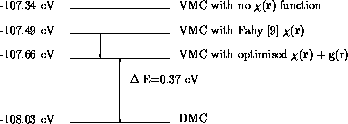 and has zero
value and derivative at r=L. The
function is of course much simpler in that it is a function of one
variable, r, the electron-ion separation.
and has zero
value and derivative at r=L. The
function is of course much simpler in that it is a function of one
variable, r, the electron-ion separation.



Having failed to resolve the difference in the VMC and DMC energies by adding a new functional form to the Jastrow factor, it was decided to return attention to and to see if a new short range function, again centered on the ion cores, could produce any further reduction in the VMC energy.
The requirements for the function are very similar to those of .
It must be the most general polynomial function, subject to the
constraint that it has zero derivative as  and has zero
value and derivative at r=L. The
function is of course much simpler in that it is a function of one
variable, r, the electron-ion separation.
and has zero
value and derivative at r=L. The
function is of course much simpler in that it is a function of one
variable, r, the electron-ion separation.

where L again is the range of the function,  is a
rescaled r and the
is a
rescaled r and the  are the Chebyshev coefficients.
are the Chebyshev coefficients.
Another set of optimisations of were performed in which 6 stars
of  were
optimised and a further 6 parameters in
were
optimised and a further 6 parameters in  were optimised (5 for
were optimised (5 for
 to
to  and B). Again the 10,000 configurations
used were those calculated from a VMC calculation based on the best so far. The same values of L=3.0, 3.5, 4.0, 5.0 were used.
The best results obtained are illustrated in Figure
and B). Again the 10,000 configurations
used were those calculated from a VMC calculation based on the best so far. The same values of L=3.0, 3.5, 4.0, 5.0 were used.
The best results obtained are illustrated in Figure  .
.

Figure: Reduction in energy using g(r) in ¸
As can be seen in Figure  , the introduction of g(r)
reduces the VMC energy by a
further 0.05eV per atom compared to the best result when optimising
expressed as a Fourier expansion. Again g(r) has little effect on
the variance, it was reduced from 2.56 to 2.54.
, the introduction of g(r)
reduces the VMC energy by a
further 0.05eV per atom compared to the best result when optimising
expressed as a Fourier expansion. Again g(r) has little effect on
the variance, it was reduced from 2.56 to 2.54.